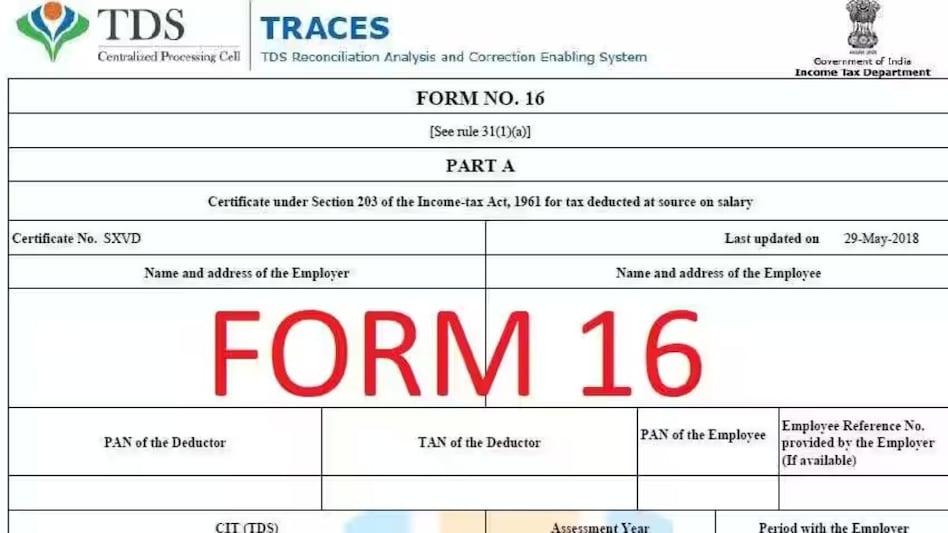 Employers are mandated by income tax rules to file their e-TDS returns for the January-March quarter by May 31. Following this, the TDS certificate, Form 16, must be issued by June 15.
Employers are mandated by income tax rules to file their e-TDS returns for the January-March quarter by May 31. Following this, the TDS certificate, Form 16, must be issued by June 15.
 Employers are mandated by income tax rules to file their e-TDS returns for the January-March quarter by May 31. Following this, the TDS certificate, Form 16, must be issued by June 15.
Employers are mandated by income tax rules to file their e-TDS returns for the January-March quarter by May 31. Following this, the TDS certificate, Form 16, must be issued by June 15.As the financial year draws to a close, many salaried employees are preparing to receive their Form 16, a crucial document for filing Income Tax Returns (ITRs). Form 16, which details salary income, tax deductions, and exemptions, is essential due to its inclusion of Tax Deducted at Source (TDS) information.
However, this form's accuracy is paramount, as discrepancies can lead to significant issues with tax filings. One key step in ensuring accuracy is cross-verifying Form 16 with Form 26AS, a consolidated tax credit statement linked to the taxpayer's Permanent Account Number (PAN). This comparison helps in identifying any mismatches in TDS credits and other income not reported to the employer, such as income from fixed deposits or freelance work.
Form 16 consists of two parts: Part A, which includes the employer's Tax Deduction Account Number (TAN), the employee's PAN, and a summary of the salary paid along with TDS deposited, and Part B, which details the salary breakdown, perquisites, and deductions under various tax sections like 80C and 80D. Errors in these entries, such as incorrect PAN numbers or missed deductions, can lead to TDS mismatches between Form 16 and Form 26AS. Hence, verifying that the PAN is correctly recorded in the employer's records is crucial to avoid such discrepancies. Any mismatch should be promptly reported to the employer's HR or payroll team for correction.
Employers are mandated by income tax rules to file their e-TDS returns for the January-March quarter by May 31. Following this, the TDS certificate, Form 16, must be issued by June 15. Despite this timeline, employees should proactively check for any errors in Form 16 and ensure that all deductions and exemptions have been accurately captured. In cases where deductions are missing, these can still be claimed while filing the ITR, provided the taxpayer retains relevant documents as evidence for future verification by the tax department.
Form 26AS serves as a comprehensive view of all tax credits available to a taxpayer, including TDS from various sources beyond employment, such as banks and property transactions. It is crucial for verifying that all taxes deducted have been deposited with the government. Commonly missed in Form 16 are incomes from fixed deposits or freelance work, which could appear in Form 26AS. If unreported in the ITR, such omissions might trigger tax notices or demands for additional tax payments. Therefore, cross-verifying these forms helps ensure all income is accurately reported.
Form 16 is only as accurate as the information that goes into it. It's common to see mistakes like having the wrong PAN number, missing out on deductions because you forgot to submit proof, errors in calculating HRA or LTA exemptions, and inaccurate tax calculations. Sometimes, employers might even apply the wrong tax slab or forget to include income from a previous job, which can cause discrepancies.
If you notice any mistakes in either Part A or Part B, don't worry! Just get in touch with your employer's HR or payroll team. For errors in Part A, which includes TDS details from the TRACES portal, your employer will need to correct them through a revised TDS return. As for mistakes in Part B, where your salary and exemption details are listed by the employer, simply ask the payroll or HR department to issue a corrected Form 16 for you.
The importance of using Form 16 effectively while filing ITRs cannot be overstated. Any errors detected should be communicated to the relevant employer department for correction. Form 16 is only as accurate as the data inputted, and common mistakes include wrong tax slab applications or overlooking previous employment income. Staying vigilant about these details can help prevent tax-related issues and ensure a smoother filing process.